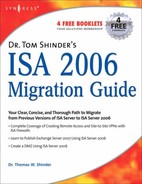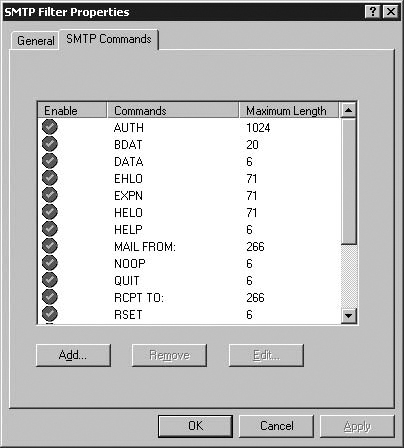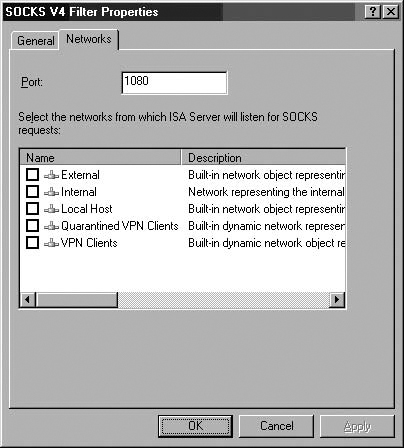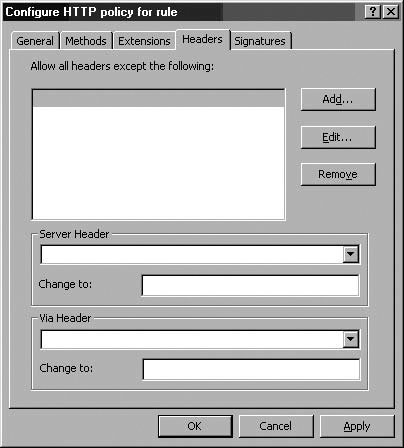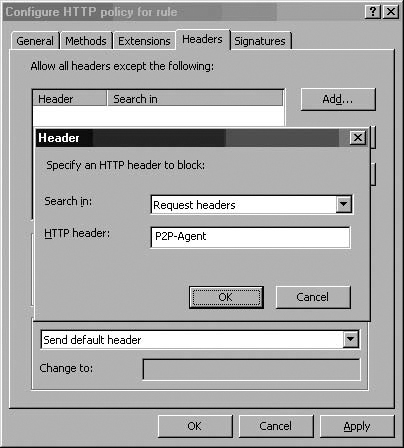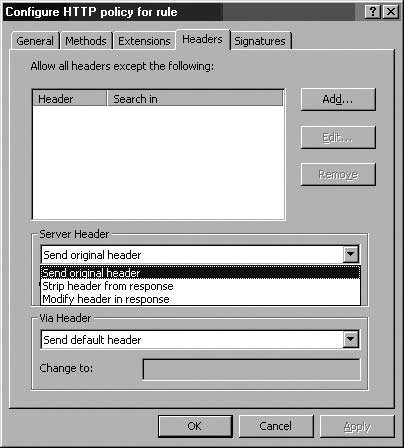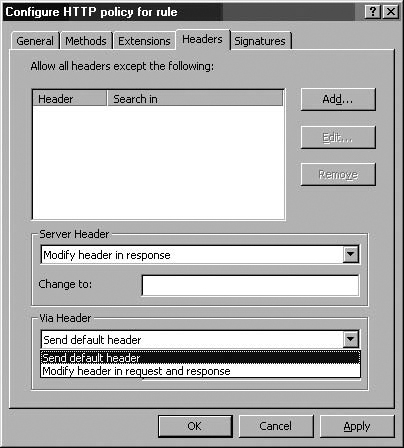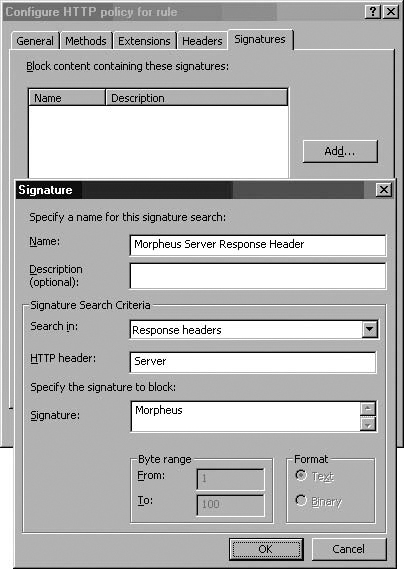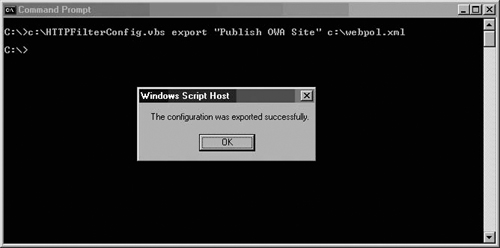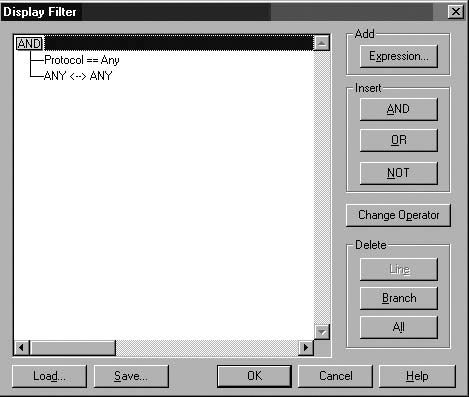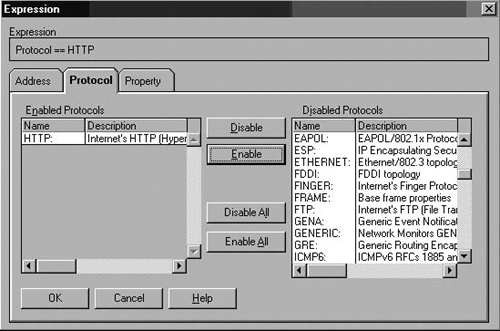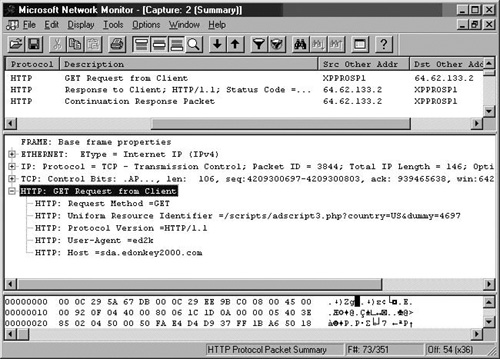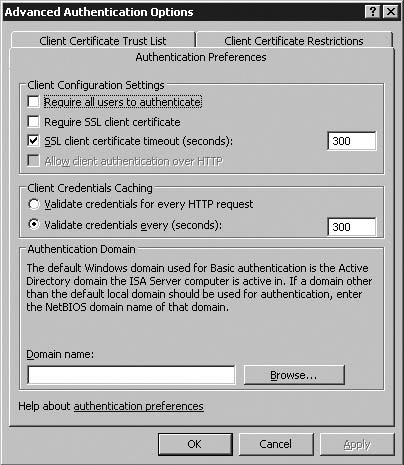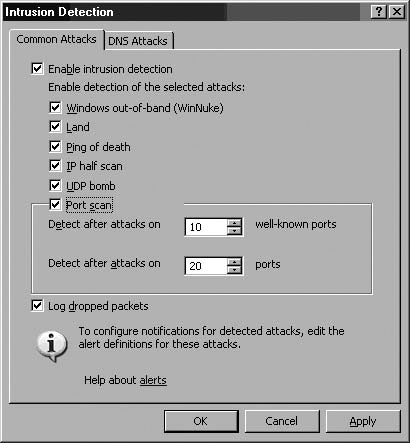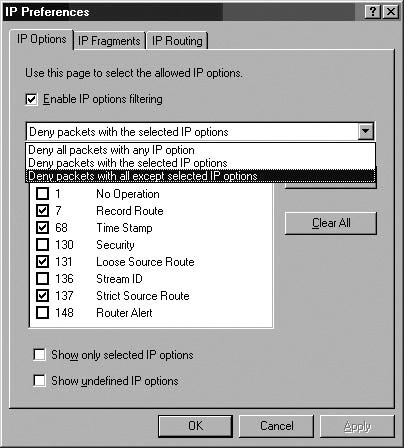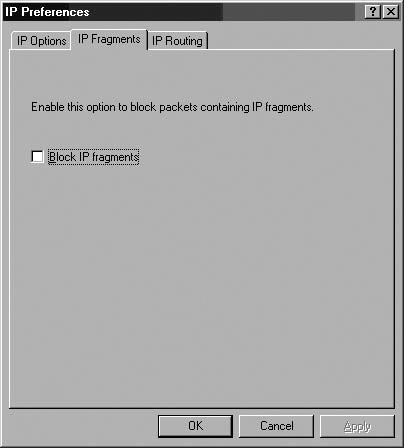Solutions in this chapter:
The ISA firewall is able to perform both stateful filtering and stateful application layer inspection. Its stateful filtering feature set makes it a network layer stateful firewall in the same class as any hardware firewall that performs stateful filtering at the network and transport layers. Stateful filtering is often referred to as stateful packet inspection, which is a bit of a misnomer because packets are Layer 3 entities, and to assess connection state, Layer 4 information must be assessed.
However, in contrast to traditional packet filter-based stateful hardware firewalls, the ISA firewall is able to perform stateful application layer inspection, which enables it to fully inspect the communication streams passed by it from one network to another. In contrast to stateful filtering where only the network and transport layer information is filtered, true stateful inspection requires that the firewall be able to analyze and make decisions on all layers of the communication, including the most important layer, the application layer.
The Web filters perform stateful application layer inspection on communications handled by the ISA firewall’s Web Proxy components. The Web Proxy handles connections for HTTP, HTTPS (SSL), and HTTP tunneled FTP connections. The Web filters take apart the HTTP communications and expose them to the ISA firewall’s application layer inspection mechanisms, examples of which include the HTTP Security filter and the OWA forms-based authentication filter.
The Application filters are responsible for performing stateful application layer inspection on non-HTTP protocols, such as SMTP, POP3, and DNS. These application layer filters also take apart the communication and expose them to deep stateful inspection at the ISA firewall.
Web and Application filters can perform two duties:
Protocol access
Protocol security
Protocol access allows access to protocols that require secondary connections. Complex protocols may require more than one connection, either inbound or outbound through the ISA firewall. SecureNAT clients require these filters to use complex protocols because the SecureNAT client does not have the power of the Firewall client. In contrast to the Firewall client that can work together with the ISA firewall to negotiate complex protocols, the SecureNAT client is a simple NAT client of the ISA firewall and requires the aid of application filters to connect using these complex protocols (such as FTP or MMS).
Protocol security protects the connections moving through the ISA firewall. Protocol security filters such as the SMTP and DNS filters inspect the communications that apply to those filters and block connections that are deemed outside of secure parameters. Some of these filters block connections that may represent buffer overflows (such as the DNS and SMTP filters), and some of them perform much deeper inspection and block connections or content based on policy (such as the SMTP Message Screener).
The ISA firewall includes a number of Application filters. In this section, we discuss:
The ISA firewall’s SMTP filter configuration interface can be accessed by opening the Microsoft Internet Security and Acceleration Server 2006 management console, expand the server name, and then expand the Configuration node. Click the Add-ins node. In the Details Pane, double-click the SMTP Filter. Click the SMTP Commands tab. (See Figure 7.1.)
The settings on the SMTP Commands tab are mediated by the SMTP filter component. The SMTP Message Screener does not evaluate SMTP commands and does not protect against buffer overflow conditions. The commands in the list are limited to a predefined length. If an incoming SMTP connection sends a command that exceeds the length allowed, the connection is dropped. In addition, if a command that is sent over the SMTP channel is not on this list, it is dropped. (See Figure 7.1.)
The ISA firewall’s DNS filter protects the DNS server published by the ISA firewall using Server Publishing Rules. You can access the configuration interface for the DNS filter’s attack prevention configuration page in the Intrusion Detection dialog box. Expand the server name and then expand the Configuration node. Click the General node.
In the Details Pane, click the Enable Intrusion Detection and DNS Attack Detection link. In the Intrusion Detection dialog box, click the DNS Attacks tab. On the DNS Attacks tab, put a checkmark in the Enable detection and filtering of DNS attacks checkbox. (See Figure 7.2.)
Once detection is enabled, you can then enable prevention. You can protect yourself from three attacks:
DNS host name overflow
DNS length overflow
DNS zone transfer
The DNS host name overflow and DNS length overflow attacks are DNS denial-of-service (DoS) type attacks. The DNS DoS attack exploits the difference in size between a DNS query and a DNS response, in which all of the network’s bandwidth is consumed by bogus DNS queries. The attacker uses the DNS servers as “amplifiers” to multiply the DNS traffic.
The attacker begins by sending small DNS queries to each DNS server that contains the spoofed IP address of the intended victim. The responses returned to the small queries are much larger, so if a large number of responses are returned at the same time, the link will become congested and denial of service will take place.
One solution to this problem is for administrators to configure DNS servers to respond with a “refused” response, which is much smaller than a name resolution response, when they receive DNS queries from suspicious or unexpected sources.
You can find detailed information for configuring DNS servers to prevent this problem in the U.S. Department of Energy’s Computer Incident Advisory Capability information bulletin J-063, available at www.ciac.org/ciac/bulletins/j-063.shtml.
The POP Intrusion Detection filter protects POP3 servers you publish via ISA firewall Server Publishing Rules from POP services buffer overflow attacks. There is no configuration interface for the POP Intrusion Detection filter.
The SOCKS v4 filter is used to accept SOCKS version 4 connection requests from applications written to the SOCKS version 4 specification. Windows operating systems should never need to use the SOCKS filter because you can install the Firewall client on these machines to transparently authenticate to the ISA firewall and support complex protocol negotiation.
For hosts that cannot be configured as Firewall clients, such as Linux and Mac hosts, you can use the SOCKS v4 filter to support them. The SOCKS v4 filter is disabled by default. To enable the filter, open the Microsoft Internet Security and Acceleration Server 2006 management console, expand the server name, and then expand the Configuration node. Click the Add-ins node. In the Details Pane, right-click the SOCKS V4 filter and click Enable.
You will need to configure the SOCKS V4 filter to listen on the specific network(s) for which you want it to accept connections. Double-click the SOCKS V4 filter. In the SOCKS V4 Filter Properties dialog box, click the Networks tab. On the Networks tab, you can configure the Port on which the SOCKS filter listens for SOCKS client connections. Next, put a checkmark in the checkbox next to the network for which you want the SOCKS filter to accept connections. Click Apply and then click OK. (See Figure 7.3.)
The SOCKS v4 filter supports SOCKS v4.3 client applications. The SOCKS filter is a generic sockets filter that supports all client applications that are designed to support the SOCKS v4.3 specification. The SOCKS filter performs duties similar to that performed by the Firewall client. However, there are some significant differences between how SOCKS and the Firewall client work:
The Firewall client is a generic Winsock Proxy client application. All applications designed to the Windows Sockets specification will automatically use the Firewall client.
The SOCKS filter supports applications written to the SOCKS v4.3 specification.
When the Firewall client is installed on the client machine, all Winsock applications automatically use the Firewall client, and user credentials are automatically sent to the ISA firewall. In addition, the Firewall client will work with the ISA firewall service to manage complex protocols that require secondary connections (such as FTP, MMS, and many others).
The SOCKS client must be configured on a per-application basis. Each application must be explicitly configured to use the ISA firewall as its SOCKS server. When the application is configured to use the ISA firewall as its SOCKS server, the SOCKS filter will manage complex protocols for the SOCKS client application.
The SOCKS 4.3a filter included with the ISA firewall does not support authentication. SOCKS 5 introduced the capability to authenticate the client application that attempts to access content through the SOCKS proxy.
We always recommend that you use the Firewall client because of the impressive advantages it provides by allowing you the ability to authenticate all Winsock connections made through the ISA firewall. However, SOCKS is a good “second best” when you cannot install the Firewall client.
The FTP Access filter is used to mediate FTP connections between Protected Network clients and FTP servers on the Internet, and from external hosts and published FTP servers. The FTP Access filter supports both PASV and PORT (passive and standard) mode FTP connections.
The FTP Access filter is required for SecureNAT clients because FTP uses secondary connections for PORT-mode FTP connections. FTP is a complex protocol that requires outbound connections from the FTP PORT-mode client and new secondary inbound connections from the FTP server. While the Firewall client does not require application filter support for secondary connections, SecureNAT clients do require application layer filter support, which is why the ISA firewall dev team included the FTP Access application filter.
ISA Firewall Secret
If you plan to support PORT-mode FTP client connections, make sure that IP Routing is enabled on the ISA firewall (the default setting). When IP Routing is enabled, the secondary connections are handled in kernel mode rather than user mode. This kernel-mode handling of the secondary connections (which are data transfers from the FTP server to the FTP client) will significantly increase performance.
Stefaan Pouseele, an ISA Server MVP, has written an excellent article on the FTP protocol and how FTP challenges firewall security. Check out his article, How the FTP Protocol Challenges Firewall Security at http://isaserver.org/articles/How_the_FTP_protocol_Challenges_Firewall_Security.html.
There is no configuration interface for the FTP Access filter. However, if there is an Access Rule that applies to FTP connection, the right click menu on the Access Rule will allow you to Configure FTP. The Configure FTP option allows you to control whether or not FTP uploads are allowed.
The H.323 filter is used to support H.323 connections through the ISA firewall. To configure the H.323 filter, open the Microsoft Internet Security and Acceleration Server 2006 management console and expand the server name. Next, expand the Configuration node and click the Add-ins node. Double-click the H.323 Filter entry in the Details Pane.
In the H.323 Filter Properties dialog box, click the Call Control tab. You have the following options:
Use this Gatekeeper
Use DNS gateway lookup and LRQs for alias resolution
Allow audio
Allow video
Allow T120 and application sharing
Click the Networks tab. On the Networks tab, put a checkmark in the checkbox to the left of the networks on which you want the H.323 filter to accept connections requests.
The MMS filter supports Microsoft Media Services connections through the ISA firewall for Access Rules and Server Publishing Rules. The MMS filter is an access filter that allows SecureNAT client access to the complex protocols and secondary connections required to connect to Microsoft Media Services hosted content. Firewall clients do not require the help of the MMS filter to connect to MMS servers. There is no configuration interface for the MMS filter.
The PNM filter supports connections for the Progressive Networks Media Protocol from Real Networks. The PNM filter is an access filter allowing SecureNAT client access to the complex protocols and secondary connection required to connect to Progressive Networks Media servers. There is no configuration interface for the PNM filter.
The PPTP filter supports PPTP connections through the ISA firewall for outbound connections made through Access Rules and inbound connections made through Server Publishing Rules. The ISA firewall’s PPTP filter differs from the ISA Server 2000 PPTP filter in that it supports both inbound and outbound PPTP connections. The ISA Server 2000 PPTP filter only supports outbound PPTP connections.
The PPTP filter is required by both SecureNAT and Firewall clients. In fact, a machine located on an ISA firewall protected network must be configured as a SecureNAT client to use the PPTP filter to connect to PPTP VPN servers through the ISA firewall. The reason for this is that the Firewall client does not mediate non-TCP/UDP protocols. The PPTP VPN protocol requires the use of the Generic Routing Encapsulation (GRE) protocol (IP Protocol 47) and TCP protocol 1723. The TCP session is used by PPTP for tunnel management.
When the outbound access to the PPTP protocol is enabled, the PPTP filter automatically intercepts the GRE and TCP connections made by the PPTP VPN client. You do not need to create an Access Rule allowing outbound access to TCP 1723 for VPN clients.
The RPC filter is used to mediate RPC connections to servers requiring Remote Procedure Calls (RPCs) for both outbound connections using Access Rules and inbound connections using Server Publishing Rules. This includes secure Exchange RPC publishing.
There is no configuration interface for the RPC filter.
The RTSP filter supports Microsoft Real Time Streaming Protocol connections through the ISA firewall for Access Rules and Server Publishing Rules. The RTSP filter is an access filter that allows SecureNAT client access to the complex protocols and secondary connections required to connect to Microsoft Real Time Streaming Protocol hosted content (such as that on Windows Server 2003 Microsoft Media Servers). Firewall clients do not require the help of the MMS filter to connect to MMS servers.
There is no configuration interface for the RTSP filter.
ISA firewall Web filters are used to mediate HTTP, HTTPS, and FTP tunneled (Web proxied) connections through the ISA firewall. In this section, we discuss the following Web filters:
HTTP Security filter
ISA Server Link Translator
Web Proxy filter
SecurID filter
OWA Forms-based Authentication filter
The ISA firewall’s HTTP Security filter is one of the key application layer filtering and inspection mechanisms included with the ISA firewall. The HTTP Security filter allows the ISA firewall to perform application layer inspection on all HTTP communications moving through the ISA firewall and block connections that do not match your HTTP security requirements.
The HTTP Security filter is tightly tied to the Web Proxy filter. When the Web Proxy filter is bound to the HTTP protocol, all communications outbound through the ISA firewall with a destination port of TCP 80 are subjected to the HTTP Security filter’s deep application layer inspection. We’ll see later how to unbind the Web Proxy filter from the HTTP protocol if you do not want all communications to be scrubbed by the HTTP Security filter.
The HTTP Security filter is applied on a per-rule basis, and you can apply different HTTP filtering properties on each rule that allows outbound HTTP communications. This provides you very granular, fine-tuned control over what type of connections can move over the HTTP channel. In addition, you can bind the Web Proxy filter to other ports and enforce HTTP Security Filter policy over connections moving over alternate ports. This provides you another potent weapon against users and applications that try to subvert your network and Firewall Security policy by tunneling Web connections over alternate ports.
In this section, we discuss:
Overview of HTTP Security Filter Settings
HTTP Security Filter Logging
Disabling the HTTP Security Filter for Web Requests
Exporting and Importing HTTP Security Filter Settings
Investigating HTTP Headers for Potentially Dangerous Applications
Example HTTP Security Filter Policies
Commonly Blocked Application Signatures
The Dangers of SSL Tunneling
The HTTP Security filter includes a number of tabs that allow you precise control over what HTTP communications are allowed through the ISA firewall on a per-rule basis. Configuration of the HTTP Security filter is done on the following tabs:
General
Methods
Extensions
Headers
Signatures
On the General tab, you can configure the following options (see Figure 7.4):
Maximum header length
Payload length
Maximum URL length
Verify normalization
Block high bit characters
Block responses containing Windows executable content
The Maximum headers length (bytes) option allows you to configure the maximum length of all headers included in a request HTTP communication. This setting applies to all rules that use the HTTP Security filter. This setting protects you from attacks that try to overflow Web site buffers by sending excessively long headers to the Web server. If you set the value too low, some applications on your site might not work correctly. If you set it too high, intruders may be able to construct a special HTTP request that could exploit known and unknown buffer overflow issues with your Web site or Web server. You might want to start with a value of 10,000 bytes and work upward from there. Your Web site administrator should be able to help you with the maximum header length required for sites your ISA firewall protects.
In the Request Payload frame, you have the option to Allow any payload length or to set a specific maximum payload length. The payload is the part of the HTTP communication that is not part of the HTTP header or command structure. For example, if you allow users to post content to your Web site (an ordering form or a discussion forum), you can set a limit on the length of their posts by unchecking the Allow any payload length checkbox and entering a custom value in the Maximum payload length (bytes) text box. Again, you may want to discuss your Web site’s requirements with your Web site administrator or Web programmer to get specific details on maximum payload length requirements for your protected Web sites.
There are several options in the URL Protection frame. The Maximum URL length (bytes) option allows you to set the maximum URL that the user can send through the ISA firewall when making a request through the firewall for a Web site. Exploits can send excessively long URLs in an attempt to execute a buffer overflow or other attack against a Web server. The default value is 10240, but you can increase or decrease this value based on your own site’s custom requirements. The Maximum query length (bytes) value allows you to set the maximum length of the query portion of the URL. The query part of the URL appears after a question mark (?) in the request URL. The default value is 10240, but you can make it longer or shorter, based on your requirements. Keep in mind that the Maximum URL length must be longer than the Maximum query length because the query is part of the URL.
The Verify normalization option is also included in the URL Protection frame. Normalization is the process of decoding so-called “escaped” characters. Web servers can receive requests that are encoded using escaped characters. One of the most common examples is when there is a space in the URL, as in the URL http://msfirewall.org/Dir%20One/default%20file.htm. The %20 is an “escape” character representing a “space.” The problem is that bad guys can also encode the “%” character and perform what is called “double encoded” requests. Double encoding can be used to attack Web servers. When the Verify Normalization option is selected, the HTTP Security filter will normalize or decode the request twice. If the request of the first and second decodings is not the same, the HTTP Security filter will drop the request. This prevents “double encoding” attacks. You should enable this feature, but keep in mind that poorly designed Web sites and Web applications are not always security aware, and may actually accept and require double encoded requests. If that is the case for sites you want to access on the Internet or for sites you publish through the ISA firewall, you will need to disable this option.
The Block high bit characters option allows you to block HTTP requests that include URLs with high bit characters in them. High bit characters are used by many languages that use extended character sets, so if you find that you can’t access Web sites that use these extended character sets in their URLs, you will need to disable this option.
The Block responses containing Windows executable content option allows you to prevent users from downloading files that are Windows executable files (such as .exe files, but any file extension can be used on a Windows executable). The HTTP Security filter is able to determine if the file is a Windows executable because the response will begin with an MZ. This can be very helpful when you need to prevent your users from downloading executables through the ISA firewall.
ISA Firewall Tip
Remember that your HTTP policy is configured on a per-rule basis. Because you can configure HTTP policy on a per-rule basis, you can enable these settings for some rules, and disable them for other rules. This per-rule HTTP policy configuration option provides you a great deal of flexibility in what content is available from specific sites to specific users at specific times.
You can control what HTTP methods are used through an Access Rule or Web Publishing Rule using the settings on the Methods tab (see Figure 7.5). You have three options:
Allow all methods
Allow only specified methods
Block specified methods (allow all others)
HTTP methods are HTTP commands that hosts can send to a Web server to perform specific actions; for example, GET, PUT, and POST. There are others that you, as a network and firewall administrator might not be familiar with, such as HEAD, SEARCH, and CHECKOUT. There are other methods that are proprietary and used by specific Web applications, such as Outlook Web Access. The Allow all methods option allows you to allow HTTP methods used in an HTTP communication through the ISA firewall.
ISA Firewall Secret
Other HTTP methods you’ll encounter when allowing access to Microsoft applications include RPC_IN_DATA and RPC_OUT_DATA, which are used for securely publishing RPC over HTTP for Outlook 2003 clients. However, remember that the filter only blocks communications set in the HTTP policy filter, so be careful not to block methods you might require, even when you’re not completely sure what the exact methods you might require will be. We recommend that you thoroughly test your filter settings and discuss with the Web application admins and developers what methods are required.
The Allow only specified methods option allows you to specify the exact methods you want to allow through the ISA firewall. If you can identify what methods are required by your Web site and Web application, then you can allow those only and block any other method. Other methods could be used to compromise your Web site, so if they’re not needed, block them.
The Block specified methods (allow all others) option allows you to allow all methods except those specific methods you want to allow. This option provides you a bit more latitude in that even if you don’t know all the methods your site might require, you might know some that are definitely not required. One example might be the POST method. If you don’t allow users to post content to your Web site, then there’s no reason to allow the POST method, and you can explicitly block it.
When you select either the Allow only specified methods or the Block specified methods (allow all others) option, you need to click the Add button to add the method you want to allow or block. The Method dialog box appears after clicking the Add button.
In the Add dialog box, you enter the method in the Method text box (Figure 7.6). You might also want to add a description of this method in the Description text box. This helps you remember what the method does and helps the next person who might need to manage your ISA firewall and isn’t aware of the insides of the HTTP protocol command set.
On the Extensions tab, you have the following options (see Figure 7.7):
Allow all extensions
Allow only specified extensions
Block specified extensions (allow all others)
Block requests containing ambiguous extensions
You can control what file extensions are allowed to be requested through the ISA firewall. This is extremely useful when you want to block users from requesting certain file types through the ISA firewall. For example, you can block users from accessing .exe, .com, .zip, and any other file extension through the ISA firewall.
The Allow all extensions option allows you to configure the Access Rule or Web Publishing Rule to allow users access to any type of file based on file extension through the ISA firewall. The Allow only specified extensions option allows you to specify the precise file extensions that users can access through the ISA firewall. The Block specified extensions (allow all others) option allows you to block specified file extensions that you deem dangerous.
If you select the Allow only specified extensions or Block specified extensions (allow all others) option, you need to click the Add button and add the extensions you want to allow or block.
The Extension dialog box appears after you click the Add button. Enter the name of the extension in the Extension text box. For example, if you want to block access to .exe files, enter .exe. Enter a description if you like in the Description (optional) text box. Click OK to save the new extension. (See Figure 7.8.)
On the Headers tab, you have the following options (see Figure 7.9):
Allow all headers except the following
Server header
Via header
An HTTP header contains HTTP communication specific information that is included in HTTP requests made from a Web client (such as your Web browser) and HTTP responses sent back to the Web client from a Web server. These headers perform multiple functions that determine the status or state of the HTTP communications and other characteristics of the HTTP session.
Examples of common HTTP headers include:
Content-length
Pragma
User-Agent
Accept-Encoding
You can accept all HTTP headers or you can block certain specific HTTP headers. There are certain HTTP headers you might always want to block, such as the P2P-Agent header, which is used by many peer-to-peer applications. If you want to block a specific HTTP header, click the Add button.
In the Header dialog box, select either the Request headers or Response headers option from the Search in drop-down list. In the HTTP header text box, enter the HTTP header you want to block. Click OK. (See Figure 7.10.)
You can configure the Server Header returned in the HTTP responses by making a selection in the Server Header drop-down list. The Server Header is an HTTP header that the Web server sends back to the Web client informing the client of the type of Web server to which the client is connecting. Intruders can use this information to attack a Web server. You have the options to:
Send original header
Strip header from response
Modify header in response
The Send original header option lets the header sent by the Web server go unchanged. The Strip header from response option allows the ISA firewall to remove the Server Header, and the Modify header in response allows you to change the header. You should change the header to confuse the attacker. Since this header isn’t required by Web clients, you can change it to something like Private or CompanyName or anything else you like.
These options all help to prevent (or at least slow down) attackers. Attackers will have to expend more effort and use alternate methods to “fingerprint” your Web server. (See Figure 7.11.)
The Via Header option allows you to control the Via Header sent to the Web client. When Web Proxy servers are located between a client and Web server, the Web Proxy server will insert a Via Header in the HTTP communication informing the client that the request was handled by the Web Proxy server in transit. Each Web Proxy server in the request path can add its own Via Header, and each sender along the response path removes its own Via Header and forwards the response to the server specified in the next Via Header on the Via Header “stack.” The Via Header settings allows you to change the name your ISA firewall includes in its own Via Header and enables you to hide the name of your ISA firewall. The default setting is for your ISA firewall to include its own Computer name in the Via Header.
You have two options:
Send default header
Modify header in request and response
The Send default header option leave the Via Header unchanged. The Modify header in request and response option allows you to change the name included in the Via Header inserted by your ISA firewall. We recommend that you change this to hide the actual name of your ISA firewall to prevent attackers from learning the actual name of your ISA firewall machine. (See Figure 7.12.)
Enter the alternate Via Header in the Change To text box.
The Signatures tab allows you to control access through the ISA firewall based on HTTP signatures you create. These signatures are based on strings contained in the following components of an HTTP communication:
Request URL
Request headers
Request body
Response headers
Response body
You access the Signature dialog box by clicking the Add button. (See Figure 7.13.)
In the Signature dialog box, enter a name for the signature in the Name text box and a description of the signature in the Description text box. This is especially helpful so that you know the purpose and rationale for this signature.
In the Search in drop-down list, select where you want the ISA firewall to search for the specified string. You have the follow options:
Request URL. When you select this option, you can enter a string that when found in the Web client’s request URL, the connection is blocked. For example, if you wanted to prevent all requests to sites that have the string Kazaa in the URL included in the Web client’s request, you enter Kazaa in the Signature text box.
Request headers. When you select this option, you enter the specific HTTP header you want the ISA firewall to check in the HTTP header text box and then enter the string in the header you want the ISA firewall to block in the Signature text box. For example, if you want to block eDonkey P2P applications, you can select this option and then User-Agent in the HTTP header text box. In the Signature text box, you then enter ed2k. Note that this option gives you more granular control than you would have if you just blocked headers in the Headers tab. If you block a specific header in the Headers tab, you end up blocking all HTTP communications that use that specific header. By creating a signature that incorporates a specific header, you can allow that HTTP header for all communications that do not include the header value you enter for the signature.
Request body. You can block HTTP communications based on the body of the Web request outside of that contained in the HTTP commands and headers. While this is a very powerful feature, it has the potential to consume a great deal of resources on the ISA firewall computer. For this reason, you need to configure the byte range you want the ISA firewall to inspect in the Byte range From and To text boxes. We don’t have any explicit recommendations on specific entries you might want to include in this section, but will provide updates on www.isaserver.org when we do.
Response headers. When you select this option, you enter the specific HTTP header you want to block based on the HTTP response returned by the Web server. You enter the specific HTTP header in the HTTP header text box and the HTTP header value in the Signature text box.
Response body. The response body option works the same as the Request body option, except it applies to the content returned to the Web client from the Web server. For example, if you want to block Web pages that contain specific strings that are identified as dangerous or inappropriate, you can create a signature to block those strings. Keep this in mind when reading about the latest Web-based attack and create a signature that blocks connections that employ such an attack.
Figure 7.14 shows some example signatures blocking some commonly encountered applications that might be considered a major security risk for corporate networks.
How do you know if your security filters are working? One way to determine the effectiveness of the entries you’ve made in the HTTP Security filter is to use the ISA firewall’s built-in log viewer. Perform the following steps to configure the ISA firewall’s built-in log viewer to view HTTP Security Filter actions:
In the Microsoft Internet Security and Acceleration Server 2006 management console, expand the server name and click the Monitoring node in the left pane of the console.
In the Monitoring node, click the Logging tab. In the Tasks tab of the Task Pane, click the Start Query link.
Right-click one of the column headers and click the Add/Remove Columns command.
In the Add/Remove Columns dialog box, click the Filter Information entry in the Available Columns list and click Add. The Filter Information entry now appears in the list of Displayed columns. Click OK.
Issue a request from a client behind the ISA firewall that would be blocked by your HTTP Security Filter settings. Figure 7.15 shows an example of a connection that was blocked because the URL contained a string that was disallowed by the HTTP Security filter.
An HTTP policy can be exported from or imported into an Access Rule that uses the HTTP protocol or a Web Publishing Rule. The HttpFilterConfig.vbs script in the SDK kit located at http://www.microsoft.com/downloads/details.aspx?familyid=16682C4F-7645-4279-97E4-9A0C73C5162E&displaylang=en can be used to export an existing HTTP policy that has already been configured in an Access Rule or Web Publishing Rule or an HTTP policy that has already been exported to a file can be imported into an existing Access Rule or Web Publishing Rule.
The HttpFilterConfig.vbs script greatly simplifies configuration of complex HTTP policies that include multiple entries for parameters such as signature, file extensions, and headers. We recommend that you export your HTTP policies after you create them in the Microsoft Internet Security and Acceleration Server 2006 management console.
In this section, we discuss how you can export and import an HTTP policy from and to a Web Publishing Rule.
ISA Firewall Tip
Jim Harrison, the Godfather of ISA firewall scripting, has several attack prevention tools and scripts on his site that automatically configure an HTTP policy as part of the attack prevention and mitigation configuration. Check out Jim’s fantastic ISA firewall tools Web site at www.isatools.org.
HTTP policies can be exported from an Access Rule or Web Publishing Rule using the HttpFilterConfig.vbs file located on the ISA 2006 CD-ROM. Follow these steps to export the HTTP policy from an existing Web Publishing Rule:
Copy the HttpFilterConfig.vbs file to the root of the C: drive.
Open a command prompt and change the focus to the root of the C: drive. Enter the following command and press Enter (notice that if the rule name has a space in it you must enclose the name in quotes):
C:Httpfilterconfig.vbs import "Publish OWA Site" c:webpol.xml
You will see a dialog box confirming that the information was successfully imported into the rule (see Figure 7.16).
HTTP policies can be imported into Access Rules that include the HTTP protocol and Web Publishing Rules. We use the same script we used when exporting an HTTP policy, the HttpFilterConfig.vbs file. To import an HTTP policy saved to an .xml file into a Web Publishing Rule named Publish OWA Site:
Copy both the .xml file and the HttpFilterConfig.vbs file from the ISA 2006 CD-ROM to the root of the C: drive. In this example, the .xml file is named webpol.xml.
Open a command prompt and change the focus to the root of the C: drive. Enter the following command and press Enter (notice that if the rule name has spaces in it, you must enclose the name in quotes):
C:Httpfilterconfig.vbs import "Publish OWA Site" c:webpol.xml
You will see a dialog box confirming that the information was successfully imported into the rule (see Figure 7.17).
One of your primary tasks as an ISA firewall administrator is to investigate characteristics of network traffic with the goal of blocking new and ever more dangerous network applications. These dangerous applications might be peer-to-peer applications, instant messaging applications, or other applications that hide by wrapping themselves in an HTTP header. Many vendors now wrap their applications in an HTTP header in an attempt to subvert your Firewall policy. Your goal as an ISA firewall administrator is to subvert the vendors’ attempt to subvert your Network Usage policy.
As you can imagine, the vendors of these applications aren’t very cooperative when it comes to getting information on how to prevent their applications from violating your firewall security. You’ll often have to figure out this information for yourself, especially for new and obscure applications.
Your main tool in fighting the war against network scumware is a protocol analyzer. Two of the most popular protocol analyzers are Microsoft Network Monitor and the freeware tool Ethereal. Both are excellent, the only major downside of Ethereal being that you need to install a network driver to make it work correctly. Since the WinPcaP driver required by Ethereal hasn’t been regression tested against the ISA firewall software, it’s hard to know whether it may cause problems with firewall stability or performance. For this reason, we’ll use the built-in version of Network Monitor included with Windows Server 2003 in the following examples.
Let’s look at a couple of examples of how you can determine how to block some dangerous applications. One such application is eDonkey, a peer-to-peer file-sharing application. The first step is to start Network Monitor and run a network monitor trace while running the eDonkey application on a client that accesses the Internet through the ISA firewall. The best way to start is by configuring Network Monitor to listen on the Internal interface of the ISA firewall, or whatever interface eDonkey or other offending applications use to access the Internet through the ISA firewall.
Stop the trace after running the offending application for a while. Since we’re only interested in Web connections moving through TCP port 80, we can filter out all other communications in the trace. We can do this with Display filters.
Click the Display menu and then click the Filter command. In the Display Filter dialog box, double-click the Protocol == Any entry. (See Figure 7.18.)
In the Expression dialog box, click the Protocol tab and then click the Disable All button. In the list of Disabled Protocols, click the HTTP protocol, click the Enable button, and then click OK. (See Figure 7.19.)
Click OK in the Display Filter dialog box. The top pane of the Network Monitor console now only displays HTTP connections. A good place to start is by looking at the GET requests, which appear as GET Request from Client in the Description column. Double-click on the GET requests and expand the HTTP: Get Request from Client entry in the middle form. This displays a list of request headers.
In Figure 7.20, you can see that one of the request headers appears to be unusual (only if you have experience looking at Network Monitor traces; don’t worry, it won’t take long before you get good at this). The HTTP: User-Agent =ed2k seems like it might be specific for eDonkey2000. We can use this information to create an HTTP Security Filter entry to block the User-Agent Request Header value ed2k.
You can do this by creating an HTTP Security Filter signature using these values. Figure 7.21 shows what the HTTP Security Filter signature would look like to block the eDonkey application.
Another example of a dangerous application is Kazaa. Figure 7.22 shows a frame displaying the GET request the Kazaa client sends through the ISA firewall. In the list of HTTP headers, you can see one that can be used to help block the Kazaa client. The P2P-Agent HTTP request header can be blocked completely, or you can create a signature and block the P2P-Agent HTTP request header when it has the value Kazaa. You could also block the Host header in the HTTP request header when the value is set as desktop.kazaa.com.
Creating HTTP Security Filter policies can take some time. You need to run the required applications and then determine the required methods, extensions, headers, and other signatures that are specific for your application. While the effort is well spent, sometimes you need to get critical applications up and running quickly.
For this reason, we include a couple of example HTTP Security Filter policies you can use right away to protect IIS Web sites and Outlook Web Access sites.
Table 7.1 provides the defaults of a good default Web site HTTP Security Filter policy you can use. This policy allows the most common methods required for simple Web sites and restricts extensions that might allow an attacker to compromise your site. There are also several HTTP signatures included that block common strings that Internet criminals might use to compromise your Web site or server.
Table 7.1. Example HTTP Security Filter for Generic Web Sites
Tab | Parameter |
|---|---|
General | Maximum header length is 32768. |
Allow any payload length is selected. | |
Maximum URL length is 260. | |
Maximum query length is 4096. | |
Verify normalization is selected. | |
Block high bit characters is not selected. | |
Methods | Allow only specified methods: |
GET | |
HEAD | |
POST | |
Extensions | Block specified extensions (allow all others): |
.exe | |
.bat | |
.cmd | |
.com | |
.htw | |
.ida | |
.idq | |
.htr | |
.idc | |
.shtm | |
.shtml | |
.stm | |
.printer | |
.ini | |
.log | |
.pol | |
.dat | |
Headers | No changes from the default. |
Signatures (Request URL) | Block content containing these signatures |
.. | |
./ | |
: | |
% | |
& | |
Tab | Parameter |
Table 7.2 provides settings you can use to configure an HTTP Security Filter policy for OWA publishing. Notice the methods required by OWA. You can see these in action by using the ISA firewall’s built-in log filter and watching the HTTP Methods column.
Table 7.2. HTTP Security Filter Settings for OWA Web Publishing Rules
Tab | Parameter |
|---|---|
General | Maximum header length is 32768. |
Allow any payload length is selected. | |
Maximum URL length is 260. | |
Maximum query length is 4096. | |
Verify normalization is selected. | |
Block high bit characters is not selected. | |
Methods | Allow only specified methods: |
GET | |
POST | |
PROPFIND | |
PROPPATCH | |
BPROPPATCH | |
MKCOL | |
DELETE | |
BDELETE | |
BCOPY | |
MOVE | |
SUBSCRIBE | |
BMOVE | |
POLL | |
SEARCH | |
Extensions | Block specified extensions (allow all others): |
.exe | |
.bat | |
.cmd | |
.com | |
.htw | |
.ida | |
.idq | |
.htr | |
.idc | |
.shtm | |
.shtml | |
.stm | |
.printer | |
.ini | |
.log | |
.pol | |
.dat | |
Headers | No changes from the default. |
Signatures (Request URL) | Block content containing these signatures |
./ | |
: | |
% | |
& |
ISA Firewall Tip
You may not want to include the & character and .exe extension. You need to allow .exe for downloading of the S/MIME control. However, because HTTP Security Filter policy is applied on a per-rule basis, we suggest you create a separate rule allowing access for specific Outlook Web Access needs, and order it before the rule that blocks access based on Table 7.3. The allow rule would allow access only to the OWA directory containing those controls. If you do not allow the & character in requests, certain functions, like Calendaring, will not work correctly.
Table 7.3. HTTP Security Filter Policy Settings for RPC-over-HTTP Web Publishing Rule
Tab | Parameter |
|---|---|
General | Maximum headers length is 32768. |
Maximum Payload Length: 2000000000. | |
Maximum URL length is 16384. | |
Maximum query length is 4096. | |
Verify normalization is selected. | |
Block high bit characters is not selected. | |
Methods | Allow only specified methods: |
RPC_IN_DATA | |
RPC_OUT_DATA | |
Extensions | No changes from the default. |
Headers | No changes from the default. |
Signatures (Request URL) | No changes from the default. |
Table 7.3 shows entries for an HTTP Security Filter policy you can use for an RPC-over-HTTP Web Publishing Rule. Notice the unusual HTTP methods used by the Outlook 2003 RPC-over-HTTP protocol.
While we consider it an entertaining pastime spending long evenings with Network Monitor and discovering how to block dangerous applications, not all ISA firewall administrators share this predilection. For those of you who need to configure your ISA firewall to protect your network from dangerous applications as soon as possible, we provide the information in Tables 7.4 and 7.5.
Table 7.4. Sample Signatures for Blocking Commonly Encountered Dangerous Applications
Application | Location | HTTP Header | Signature |
|---|---|---|---|
MSN Messenger | Request headers | User-Agent: | MSN Messenger |
Windows Messenger | Request headers | User-Agent: | MSMSGS |
Netscape 7 | Request headers | User-Agent: | Netscape/7 |
Netscape 6 | Request headers | User-Agent: | Netscape/6 |
AOL Messenger (and all Gecko browsers) | Request headers | User-Agent: | Gecko/ |
Yahoo Messenger | Request headers | Host | msg.yahoo.com |
Kazaa | Request headers | P2P-Agent | Kazaa |
Kazaaclient: | |||
Kazaa | Request headers | User-Agent: | KazaaClient |
Kazaa | Request headers | X-Kazaa-Network: | KaZaA |
Gnutella | Request headers | User-Agent: | Gnutella |
Gnucleus | |||
eDonkey | Request headers | User-Agent: | e2dk |
Internet Explorer 6.0 | Request headers | User-Agent: | MSIE 6.0 |
Morpheus | Response header | Server | Morpheus |
Bearshare | Response header | Server | Bearshare |
BitTorrent | Request headers | User-Agent: | BitTorrent |
SOAP over HTTP | Request headers | User-Agent: | SOAPAction |
Response headers |
Table 7.4 lists the information you need to include in signatures to block commonly encountered dangerous applications. You use the information in this table to create a signature entry in the HTTP Security filter.
Table 7.5 contains some HTTP header values you can use to block dangerous applications. In contrast to signatures that require the HTTP header name and value, the entries in Table 7.5 can be configured in the Headers tab of the HTTP Security filter. These headers are specific for the listed dangerous applications and are not used for legitimate HTTP communications, so you do not need to specify a specific value for the HTTP headers blocked here.
Link Translation solves a number of issues that may arise for external users connecting through the ISA firewall to an internal Web site.
The ISA firewall Link Translator is implemented as an ISA firewall Web filter. Because of the Link Translator’s built-in functionality, and because it comes with a built-in default dictionary, you can use it right out of the box to solve many common problems encountered with proxy-based Web publishing scenarios.
For example, when pages on the internal Web site contain absolute URLs pointing to itself, the Link Translator will return the appropriate links to the external user, even when those URLs contain http:// prefixes and the external user connects to the Web site using https://.
The default Link Translator dictionary can also appropriately translate requests made to nonstandard ports. For example, if users connect to a Web site that is published on a nonstandard port, such as http://www.msfirewall.org:8181, link translation will include the port number in the URLs sent back to the external client.
When you enable link translation for a Web Publishing Rule, a Link Translation dictionary is automatically created. In most cases, you won’t have to add to the default dictionary.
The default dictionary includes the following entries:
Any occurrence on the Web site of the computer name specified on the To tab of the Web Publishing Rule Properties is replaced with the Web site name (or IP address). For example, if a rule redirects all requests for http://www.microsoft.com to an internal computer called SERVER1 (or 192.168.1.1), all occurrences of http://SERVER1 in the response page returned to the client are replaced with http://www.microsoft.com.
If a nondefault port is specified on the Web listener, that port is used when replacing links on the response page. If a default port is specified, the port is removed when replacing links on the response page. For example, if the Web listener is listening on TCP port 88, the responses returned to the Web client will include links to TCP port 88.
If the client specifies HTTPS in the request to the ISA firewall, the firewall will replace all occurrences of HTTP with HTTPS.
For example, suppose the ISA firewall publishes a site located on a machine with the internal name SERVER1. The ISA firewall publishes the site using the public name www.msfirewall.orgdocs. An external Web client then makes the following request:
GET /docs HTTP/1.1 Host: www.msfirewall.org
Note that the directory name in the request is not terminated by a slash (/). When the server running Internet Information Services (IIS) receives this request, it automatically returns a 302 response with the location header set to http://SERVER1/docs/, which is the internal name of the server followed by the directory name and terminated by a slash.
The ISA firewall’s Link Translator then translates the response header value to http://www.msfirewall.org/docs/.
In this example, the following entries are automatically added to the Link Translation dictionary:
http://SERVER1 is mapped to http://www.msfirewall.org
http://SERVER1:80 is mapped to http://www.msfirewall.org
https://SERVER1 is mapped to https://www.msfirewall.org
https://SERVER1:443 is mapped to https://www.msfirewall.org
For security reasons, if an initial client request was sent via SSL, all links to the same Web server are translated to SSL. The following entries are automatically included in the Link Translation dictionary:
http://SERVER1 is mapped to https://www.msfirewall.org
http://SERVER1:80 is mapped to https://www.msfirewall.org
https://SERVER1 is mapped to https://www.msfirewall.org
https://SERVER1:443 is mapped to https://www.msfirewall.org
If the published Web site uses ports other than the default HTTP and SSL ports (for example, 88 for HTTP and 488 for SSL), links containing that port number will also be translated. For example:
http://SERVER1:88 is mapped to http://www.msfirewall.org
https://SERVER1:488 is mapped to https://www.msfirewall.org
In the same way, if the ISA firewall publishes the site using a Web listener on nondefault ports (for example, 85 for HTTP and 885 for SSL), links will be translated to the published ports:
http://SERVER1 is mapped to http://www.msfirewall.org:85
http://SERVER1:80 is mapped to http://www.msfirewall.org:85
https://SERVER1 is mapped to https://www.msfirewall.org:885
https://SERVER1:443 is mapped to https://www.msfirewall.org:885
ISA Firewall Tips
Don’t end the search string in the Link Translator dictionary with a terminating character. For example, use http://SERVER1, not http://SERVER1/.
When adding an entry for a site name, also add an entry with the site name and port. For example, if you add the search string http://SERVER1 in the Link Translator dictionary, also add the search string http://SERVER1:80.
Use both http:// and https://.
Use caution when changing directory structures, as this will affect the settings in your Link Translation dictionary.
Dictionaries with a large number of entries when applied to Web sites that have many links requiring translation could detrimentally impact ISA Server performance.
While the default dictionary is effective for most simple Web publishing scenario, things get a bit stickier when you publish more complex Web sites. For more complex Web publishing scenarios, or when complex ASP code is involved (for example, with SharePoint services), it’s necessary to configure dictionary entries that map to names returned by the internal Web site.
The Link Translator checks the Content-type header of the response to determine whether link translation should be applied to the body of the message. The default settings allow for link translation only MIME types belonging to the HTML document’s content group. The ISA firewall’s Link Translator works by first looking for a Content-type header to determine if it needs to perform translation. If no Content-type header is present, the filter will look for a Content-location header to perform translation. If neither header is present, the filter will look at the file extension.
The Link Translator maps text strings according to the following rules:
The Link Translator searches for the longest strings, then shorter strings, and finally the default strings.
If the Link Translator finds a matching text string, it will then look at the next character to the right to see if it is a terminating character. The following are considered terminating characters:
;
~
<
!
”
&
‘
)
$
)
*
+
,
–
/
>
=
?
[
]
^
{
|
}
If the Link Translator finds a terminating character immediately to the right of the string, it will perform translation on that string.
For example, consider a scenario where the Link Translation dictionary is configured to replace “sps” with “extranet.external.net” and a response page returned by the Web server includes a hard-coded link to http://Sps/SpsDocs/. The Link Translator translates the string to http://extranet.external.net/SpsDocs/. However, if the response page includes a link to http://sps/sps-isa/, both instances of “sps” would be translated because they are both followed by a terminating character, resulting in http://extranet.external.net/extranet.external.net-isa/ being sent to the external client.
Because of these potential translation issues, it’s critical that you understand the behavior of link translation mapping to prevent problems with your custom Link Translator dictionaries.
You must test the behavior of the Link Translator to see if any custom dictionary entries are required. SharePoint Portal Services provides a fertile test bed for testing the Link Translator. Begin your test by connecting to a published SharePoint site using an external client and testing the functionality of the published site. You should look for links pointing to internal server names and links that use the wrong prefix (for example, http instead of https).
Be aware that some links will be included in client-side scripts returned to the browser for processing. You should therefore also view the HTML source code that is returned, not just the rendered HTML in the browser.
In the case of a published SharePoint site, it may be necessary to add custom dictionary entries. For example, even though the Link Translator is enabled, the search function on the SharePoint site may return results with both the wrong prefix (http instead of https) and internal server names.
In addition, after adding custom dictionary entries to fix these problems, the source code of the search results page contains JavaScript that includes references to the wrong prefix, causing errors to be returned to the browser when trying to perform an additional search from the search results page.
For example, after adding two dictionary entries to replace “http://” with “https://” and to replace “sps” with “extranet.external.net,” the returned source code included the following strings in the client-side JavaScript code:
f.action='http://extranet.external.net/Search.aspx', and http:\/\/extranet.external.net\/Search.aspx
To fix this problem, it is necessary to explicitly map the shorter string “http:” to “https:”. Importantly, it is necessary to include the colon (:) in the dictionary entry. Simply mapping “http” to “https” (without the colon) causes the entire site to be inaccessible.
It should be clear to you at this point that finding the correct custom dictionary entries can involve extensive and repetitive testing. Incorrect link translation mappings can break the Web site for external clients, so we highly recommend that you test configurations in your test lab before deploying link translation in a production environment.
Custom Link Translation dictionaries are configured on a per-rule basis. Remember, link translation is only performed on links returned by Web servers published by Web Publishing Rules; you do not configure Link Translation for outgoing requests to Internet Web servers.
To configure Link Translation:
Right-click the Web Publishing Rule and click Properties.
In the Web Publishing Rule’s Properties dialog box, click the Link Translation tab.
On the Link Translation tab, put a checkmark in the Replace absolute links in Web pages checkbox. Click the Add button.
In the Add/Edit Dictionary Item dialog box, enter the name of the string you want replaced in returned links in the Replace this text text box. Enter the value you want to replace the string in the With this text text box. Click OK. (See Figure 7.23.)
The dictionary entry appears in the list of dictionary entries. Click the Content Types button. (See Figure 7.24.)
In the Link Translation dialog box, select the content types to which you want to apply Link Translation. By default, only the HTML Documents content type is selected. Your selection here is global and applies to all Web Publishing Rules. Even though you can create custom dictionaries for each Web Publishing Rule, the content types are the same for all dictionaries.
ISA Firewall Warning
The Web Publishing Rule must list an explicit fully qualified domain name (FQDN) or IP address in order to perform link translation. If you configure the Web Publishing Rule to redirect for all incoming connections to the listener, you will see an error dialog box informing you that you must use an explicit FQDN or IP address on the Public tab of the Web Publishing Rule’s Properties dialog box.
The Web Proxy filter allows connections from hosts not configured as Web Proxy clients to be forwarded to the ISA firewall’s Cache and Web Proxy components. If you want only hosts that are explicitly configured as Web Proxy clients to use the ISA firewall’s Web Proxy feature set, you can unbind the Web Proxy filter by removing the checkmark from the Web Proxy Filter checkbox.
ISA Firewall Warning
Be aware that disabling the HTTP filter for the HTTP protocol is a global setting and affects all rules that use the HTTP filter. While the filter is still active for Web Proxy clients, the configuration interface for the HTTP filter is removed, and you will not be able to configure the HTTP policy for the Web Proxy clients. This problem may be solved in the future, and we will post this information at www.isaserver.org when we find a solution to this problem. (See Figure 7.25.)
The OWA Forms-Based Authentication filter is used to mediate Forms-based authentication to OWA Web sites that are made accessible via ISA firewall Web Publishing Rules. Figure 7.26 shows the configuration interface for the OWA Forms-Based Authentication filter, which is accessible from the Authentication dialog box for the Web listener.
The RADIUS Authentication filter is used to mediate RADIUS authentication for Web Proxy clients and external hosts connecting to published Web sites via Web Publishing Rules.
The RADIUS filter is used by Web listeners when the listeners are configured to use RADIUS authentication. While the RADIUS filter provides you the ability to authenticate against any RADIUS-compliant directory (including the Active Directory), it does limit you to use only RADIUS authentication on the listener configured to use RADIUS. In contrast, when using other authentication methods, such as basic or integrated authentication, you can support multiple authentication protocols on a single Web listener.
The ISA firewall performs intrusion detection and intrusion prevention. In this section, we discuss the following intrusion detection and intrusion prevention features:
Common Attacks Detection and Prevention
DNS Attacks Detection and Prevention
IP Options and IP Fragment Filtering
You can access the Intrusion Detection dialog box by opening the Microsoft Internet Security and Acceleration Server 2006 management console, expanding the server name, and then expanding the Configuration node. Click the General node.
In the General node, click the Enable Intrusion Detection and DNS Attack Detection link. This brings up the Common Attacks tab.
On the Common Attacks tab, put a checkmark in the Enable intrusion detection checkbox. Put a checkmark to the left of each of the attacks you want to prevent. If you enable the Port scan attack, enter values for the Detect after attacks ... well-known ports and Detect after attacks on ... ports. (See Figure 7.27.)
You can disable logging for packets dropped by the Intrusion Detection filter by removing the checkmark from the Log dropped packets checkbox.
The ISA firewall’s DNS filter protects DNS servers published by the ISA firewall using Server Publishing Rules. You can access the configuration interface for the DNS filter’s attack prevention configuration page in the Intrusion Detection dialog box. Expand the server name and then expand the Configuration node. Click the General node.
In the Details Pane, click the Enable Intrusion Detection and DNS Attack Detection link. In the Intrusion Detection dialog box, click the DNS Attacks tab. On the DNS Attacks tab, put a checkmark in the Enable detection and filtering of DNS attacks checkbox. (See Figure 7.28.)
Once detection is enabled, you can enable prevention, and protect yourself from three attacks:
DNS host name overflow
DNS length overflow
DNS zone transfer
The DNS host name overflow and DNS length overflow attacks are DNS DoS type attacks. The DNS DoS attack exploits the difference in size between a DNS query and a DNS response, in which all of the network’s bandwidth is tied up by bogus DNS queries. The attacker uses the DNS servers as “amplifiers” to multiply the DNS traffic.
The attacker begins by sending small DNS queries to each DNS server that contain the spoofed IP address of the intended victim. The responses returned to the small queries are much larger, so that if there are a large number of responses returned at the same time, the link will become congested and denial of service will take place.
One solution to this problem is for administrators to configure DNS servers to respond with a “refused” response, which is much smaller than a name resolution response, when they receive DNS queries from suspicious or unexpected sources.
Detailed information for configuring DNS servers to prevent this problem is contained in the U.S. Department of Energy’s Computer Incident Advisory Capability information bulletin J-063, available at http://www.ciac.org/ciac/bulletins/j-063.shtml.
You can configure what IP Options are allowed through the ISA firewall and whether IP Fragments are allowed through. Figures 7.29 and 7.30 show the configuration interfaces for IP Options filtering and IP Fragment filtering. Figure 7.31 shows a dialog box warning that enabling Fragment filtering may interfere with L2TP/IPSec and streaming media services.
TCP/IP supports source routing, which is a means to permit the sender of network data to route the packets through a specific point on the network. There are two types of source routing:
Strict source routing. The sender of the data can specify the exact route (rarely used).
Loose source record route (LSRR). The sender can specify certain routers (hops) through which the packet must pass.
The source route is an option in the IP header that allows the sender to override routing decisions that are normally made by the routers between the source and destination machines. Source routing is used by network administrators to map the network, or for troubleshooting routing and communications problems. It can also be used to force traffic through a route that will provide the best performance. Unfortunately, source routing can be exploited by hackers.
If the system allows source routing, an intruder can use it to reach private internal addresses on the LAN that normally would not be reachable from the Internet, by routing the traffic through another machine that is reachable from both the Internet and the internal machine.
Source routing can be disabled on most routers to prevent this type of attack. The ISA firewall also blocks source routing by default.
In this chapter, we discussed the ISA firewall’s application layer filtering feature set. We discussed the two main types of application filters employed by the ISA firewall: access filters and security filters. While we broke down the ISA firewall’s filters into these two main categories, this is not to say that access filters are unsecure. Both the access filters and the security filters impose requirements that the connections meet specifications of legitimate communications using those protocols.
We finished the chapter with a discussion of the ISA firewall’s intrusion detection and prevention mechanisms. You learned about common network layer attacks that can be launched against the ISA firewall and how the ISA firewall protects you against them.
